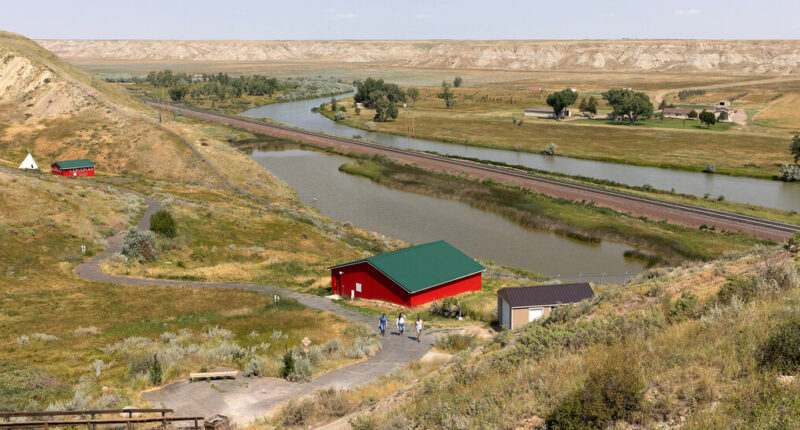
Recently, western Montana and cities like Bozeman are experiencing a surge in popularity because of the wildly successful drama “Yellowstone” and its prequels “1883” and “1923.”
But some of Montana’s most intriguing areas are those that remain untouched by the limelight.
The Hi-Line is one of them. It’s the stretch of U.S. Highway 2 that traverses northern Montana for about 650 miles.
Remote and vast, this part of Montana is a place where rows of golden wheat fields recede into endless horizons; where a long two-lane highway is colored by grain elevators, railroad cars and century-old homesteading remnants; and where you might drive past a welcome sign that reads: “RUDYARD: 596 Nice People — 1 Old Sore Head!”
In May, I traveled to the Hi-Line for a three-day road trip to explore the section between the towns of Shelby, in the west, and Malta, in the east. This 190-mile expanse was once shortgrass prairie — until the 1890s, when the Great Northern Railroad, under the leadership of James Hill, laid down steel tracks across the open plains. Soon afterward, settlers followed, wheat farms proliferated and, eventually, when roads were paved and joined together, Montana’s U.S. Highway 2 was established. Today, when people refer to the Hi-Line, they don’t just mean a strip of pavement; instead, the name refers to an area that encompasses the road, the railway and the neighboring farms, ranches, homes, businesses and communities.
In Shelby, after peering into several of its windows, it became clear that the Marias Museum of History and Art was closed. But a nearby resident who was outside in his yard referred me to his neighbor, whose wife’s family knew someone from the museum. In a matter of moments, the neighbor’s wife had the phone number of Tracy Dumas, a museum guide. Mr. Dumas’s wife, Luana, answered the neighbor’s wife’s phone call and explained that Mr. Dumas was mowing the lawn, which was exactly what Mrs. Dumas wanted him to be doing.
Thirty minutes later, on a break from his yardwork, Mr. Dumas, who has lived in Shelby his entire life — “I’m either tough or dumb,” he said — let me into the museum. The collection includes homesteading memorabilia; boxing gloves that belonged to Tommy Gibbons, a contender in Shelby’s 1923 world heavyweight title bout against Jack Dempsey; and a reptile display mounted by the renowned paleontologist Jack Horner, a Shelby native who served as an adviser on many “Jurassic Park” films.
Departing from Shelby, heading east, I watched as the sun illuminated the Sweet Grass Hills, three low volcanic mountains that are sacred to the Blackfeet Nation, whose reservation borders Glacier National Park. (The community lost its longtime and influential leader, Earl Old Person, in 2021.)
As I turned onto Tiber Road, toward Lake Elwell, I remembered the foreboding question posed to me earlier that day: “Do you know how to drive on a gravel road?”
Of course I know how to drive on a gravel road, I thought. I’ve lived in Bozeman for 29 years — though it has been a very long time since I’ve changed a tire.
The 15-mile stretch redefined “gravel road.” What followed was bumpy, barren, desolate, dusty, hot, lonely and relentless. When I finally caught a glimpse of the lake, I mistook it for a mirage. As I got closer, I realized that the clear bright green water and surrounding sandstone and shale formations were real.
Back on the paved road in Inverness, about 35 miles northeast of the lake, I discovered the Inverness Bar and Supper Club, where one of the owners, Shawn Byxbe, took turns tending bar with Dalton Dahlke, her 91-year-old father, as locals chatted about things like the weather, “summer fallow” — a period when cropland is deliberately kept out of production to allow it to rest — and high school sporting events.
“The supper club has not changed since I was a little kid,” said 36-year-old Conrad Wendland, a fifth-generation Rudyard farmer who spends the off-season in Los Angeles working for a film crew. In February, he purchased the Hi-Line Theater, a small movie establishment in Rudyard, six miles east of Inverness.
“The theater is special because it looks mostly like it did when it opened in 1949,” Mr. Wendland explained. In fact, a lot of places on the Hi-Line haven’t changed over the years, he said.
On his family farm, Mr. Wendland and his father are currently raising winter and spring wheat with the intention of diversifying their crops. It’s a dryland farming area, he said, meaning farmers don’t use irrigation to help water their crops. Instead, he explained, they employ all kinds of methods and strategies to optimize growing conditions: plowing, fertilizing, spraying, resting and rotating crops.
But with all the variables — weather, market prices, world events and nonstop physical exertion — this work is not for the faint of heart. “Despite all of the challenges, I fell in love with farming in a way that I didn’t fully expect,” Mr. Wendland said.
When I asked Ray Lipp, a crop insurance agent of 47 years who lives in the town of Hingham, seven miles east of Rudyard, about farming on the Hi-Line, he said, “We are always griping and moaning: It’s either too wet or it’s too dry or it’s this or it’s that.”
He sent me off to find a song by Wylie Gustafson called “Dry Land Farm.”
“All the neighbors’ farms got rain, but I never get a drop on mine,” the song goes.
“Yeah, things are cool for every fool but the man on the dry land farm.”
The landscape is so wide open here, Mr. Lipp’s wife, Joanie, explained, and the sky so big and boundless, that a farmer can see a potentially damaging hailstorm from miles away, possibly hours before it hits his property — and sometimes just in time to secure last-minute crop insurance.
Hailstorms, Mr. Lipp said, usually occur in June and July, in the late afternoon or early evening. Every storm is different; some are a mile wide, some 10. “But a lot of them, with the wind, they just knock everything to the ground.”
A lot of farming is gambling, he said. People hope they can get ahead and make enough to be in business next year.
“This is ‘next year’ country,” Mrs. Lipp said.
The next morning, I arrived in the city of Havre — 35 miles east of Hingham — to meet David Sageser at the local mall for a tour of the Wahkpa Chu’gn Buffalo Jump. Soon I would be driving through tribal lands, and this was an opportunity to learn about the historical culture.
Mr. Sageser began the tour as we walked through the mall’s fluorescent-lit hallway to a rear exit. Moments later, to my surprise and delight, we stood at an interpretive panel in front of a grand view: wild grasslands, majestic badlands and the iconic Milk River.
The Wahkpa Chu’gn Buffalo Jump was rediscovered in 1961 by the budding archaeologist John Brumley, who was 14 years old at the time. Approximately 2,000 years ago, the site was used to harvest bison by Indigenous peoples who hunted the animals by guiding them over a blind cliff.
Mr. Sageser concluded our tour at Havre’s H. Earl Clack Museum, where I marveled at 75-million-year-old dinosaur eggs and embryos. A few blocks away, Havre Beneath the Streets offers a fascinating look at businesses — including a saloon, a brothel and an opium den — that relocated underground in the aftermath of a citywide fire in 1904.
In Chinook, about 25 miles east of Havre, I visited the Blaine County Museum to watch “Forty Miles From Freedom,” a short multimedia piece about the history of the Nez Perce War. Later, on the 67-mile drive to Malta, my final destination on the Hi-Line, I had time to reflect on the eloquence of Chief Joseph’s speech on Oct. 5, 1877, as he surrendered near the Bears Paw Mountains: “Hear me, my chiefs. My heart is sick and sad. From where the sun now stands, I will fight no more forever!”
On the drive to Central Avenue, my phone rang. It was my 15-year-old son calling, looking for his learner’s driving permit. Our conversation reminded me of the long return trip ahead of me. But first, a stop at Coffee Central, where I briefly chatted with a few locals.
In addition to his role as coffee shop barista, Tyler Arnold is a pharmacy technician at a drugstore one block away. Mr. Arnold grew up on the Arnold Ranch, a cattle ranch about 70 miles from Malta. Unlike Mr. Wendland’s farm in Rudyard, the Arnold Ranch uses irrigation to help water its crops.
In a phone conversation after we met, Mr. Arnold talked about the family establishment and recent ranching conditions in the Malta area, which has experienced a drought for the past five-plus years. “And now grasshoppers, which thrive in dry conditions, are the worst they’ve been in years,” Mr. Arnold said. “They’ve eaten more crop than we can grow — and that goes for a lot of the farmers and ranchers around here, unfortunately.”
Sipping coffee at a table near the counter, Dyllan Herman told me he moved to Malta from Billings in April. “I always wanted to live in a small town and own my own business,” he said. “I like the quiet of a small town — and there’s good fishing at Nelson Reservoir.”
Another woman at the coffee shop invited me to a fund-raising event down the street for a high school basketball alumnus who’s fighting cancer.
The woman had recently lost her husband and daughter, and believes that life’s losses come in “clusters.”
“You’ve got to hold on to what you’ve got,” she said.
With that in mind, I headed home to Bozeman.
Janie Osborne is a photographer and writer based in Bozeman, Mont. You can follow her work on Instagram.
Follow New York Times Travel on Instagram and sign up for our weekly Travel Dispatch newsletter to get expert tips on traveling smarter and inspiration for your next vacation. Dreaming up a future getaway or just armchair traveling? Check out our 52 Places to Go in 2023.
Source: | This article originally belongs to Nytimes.com









